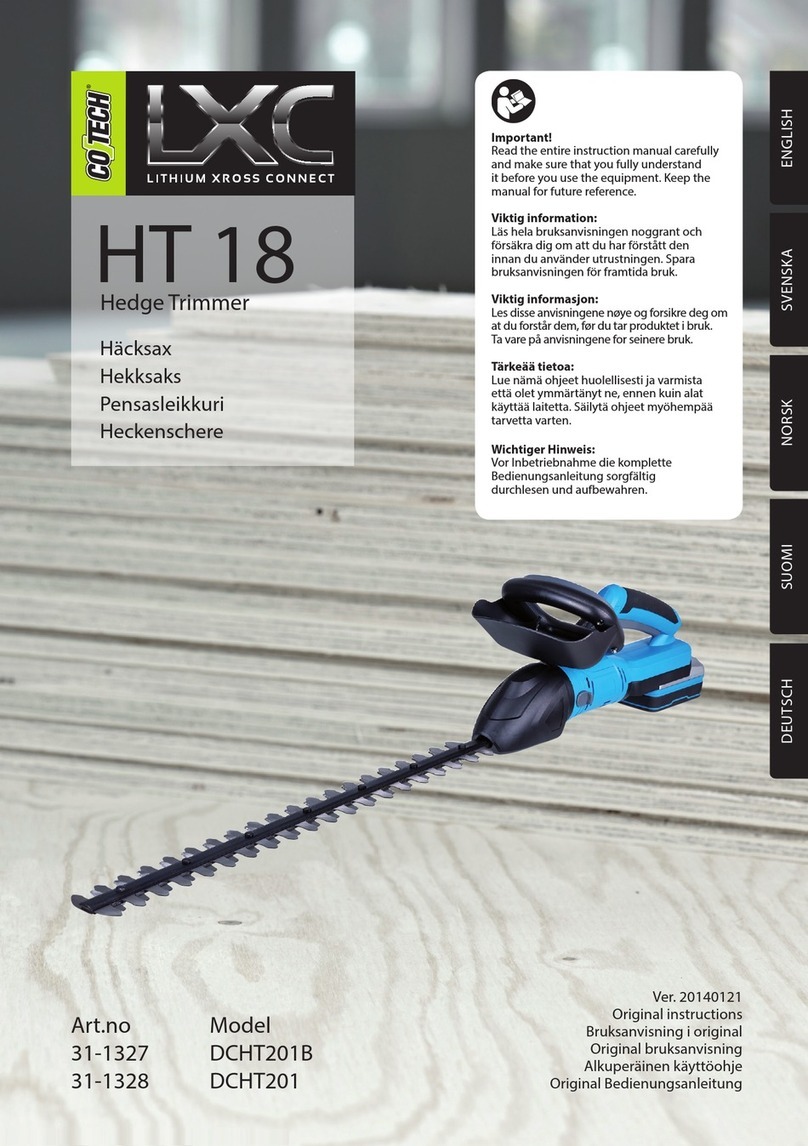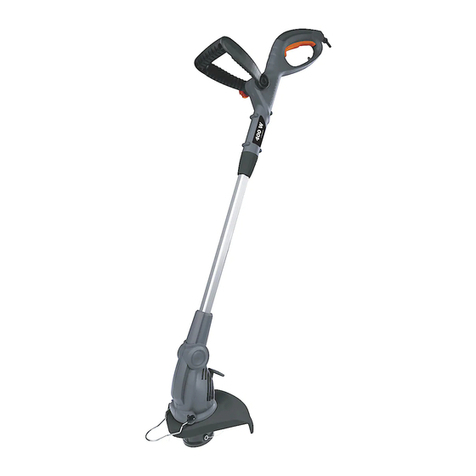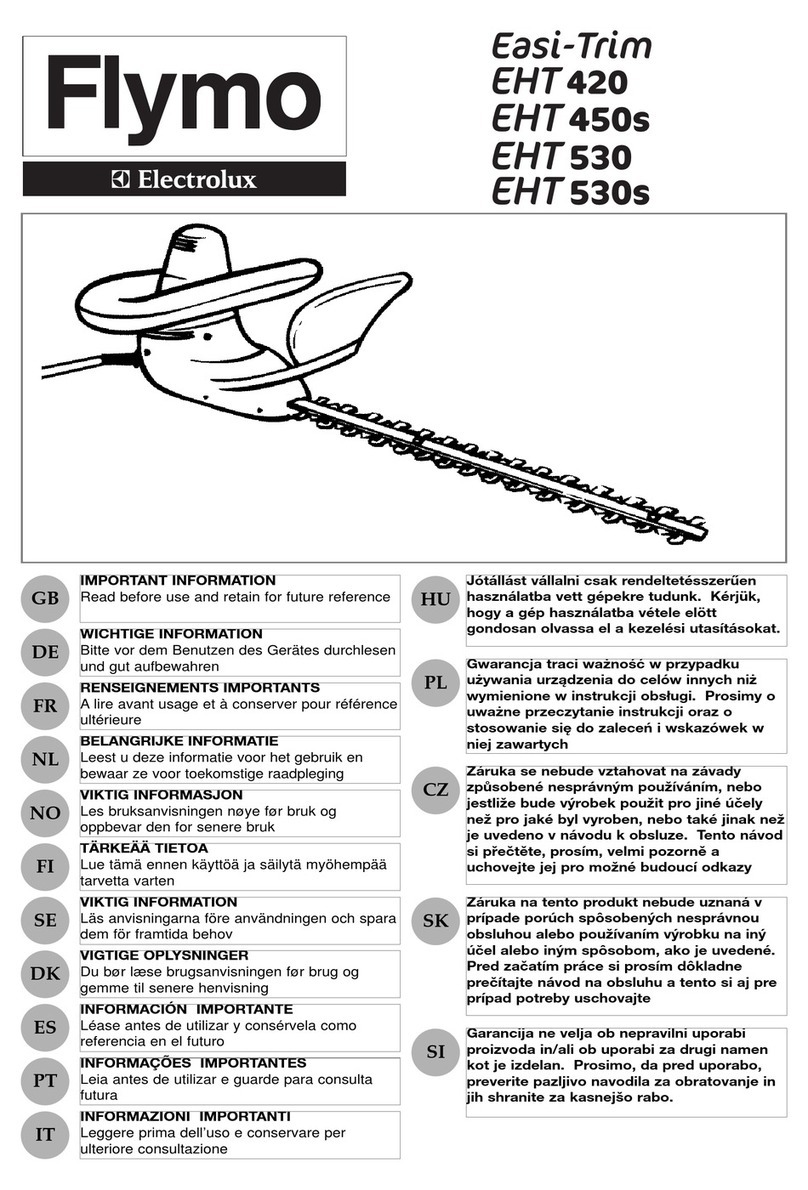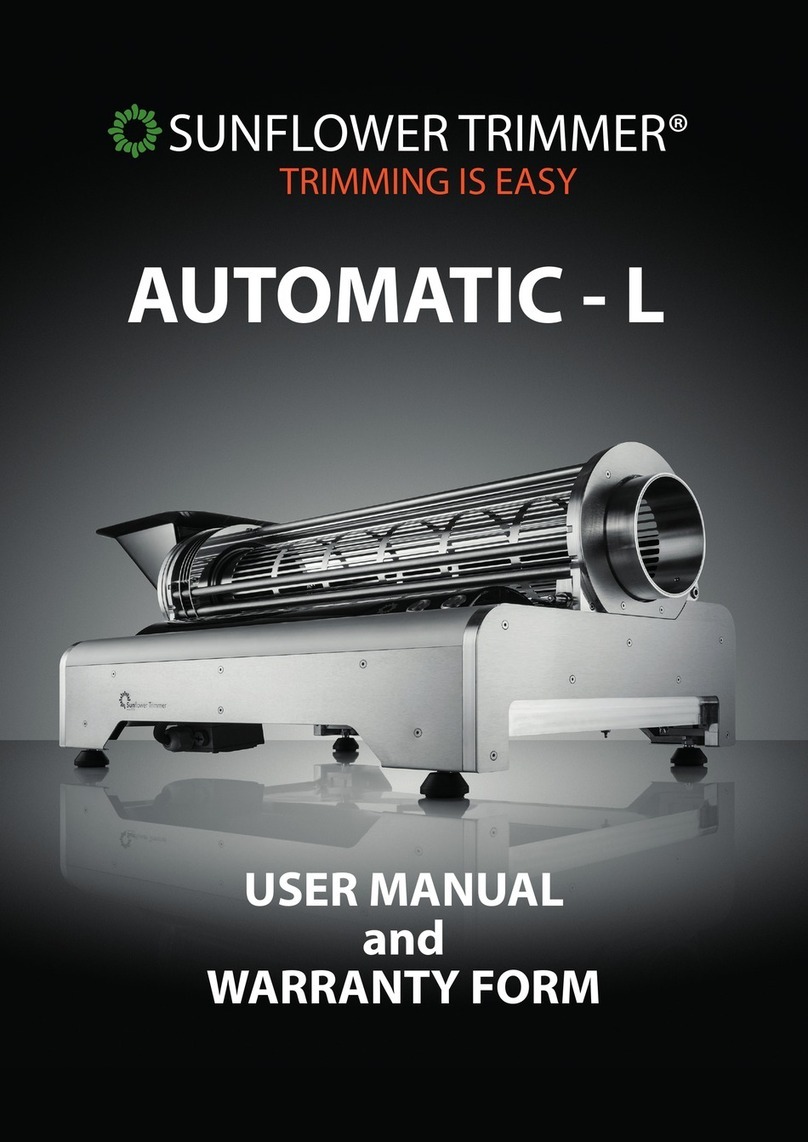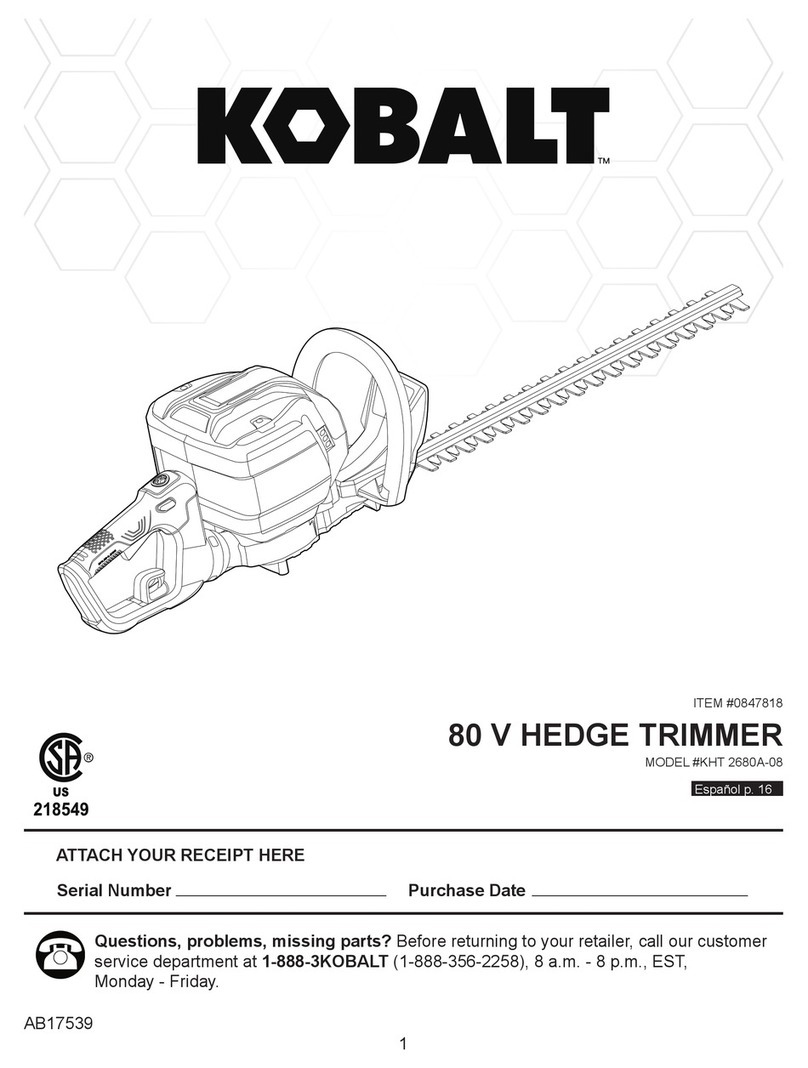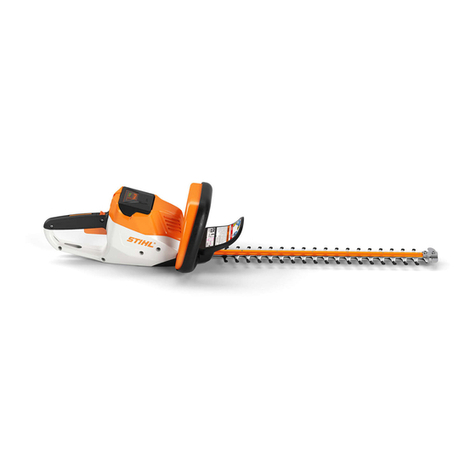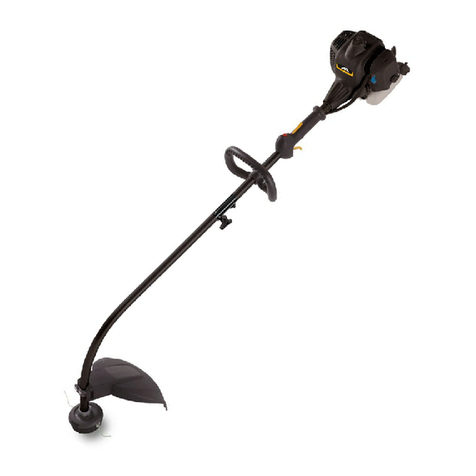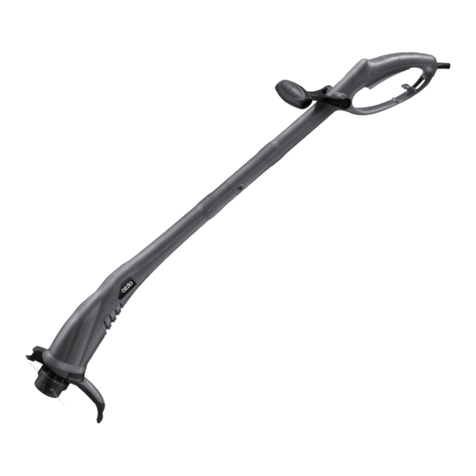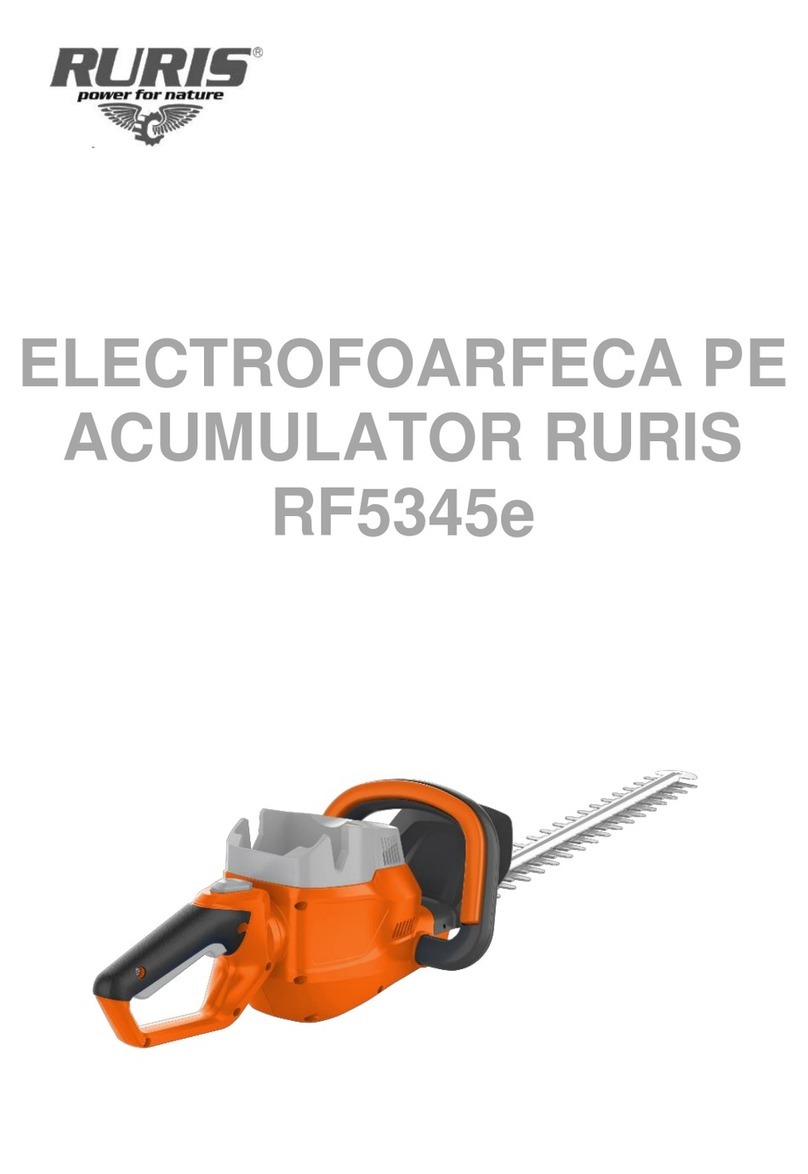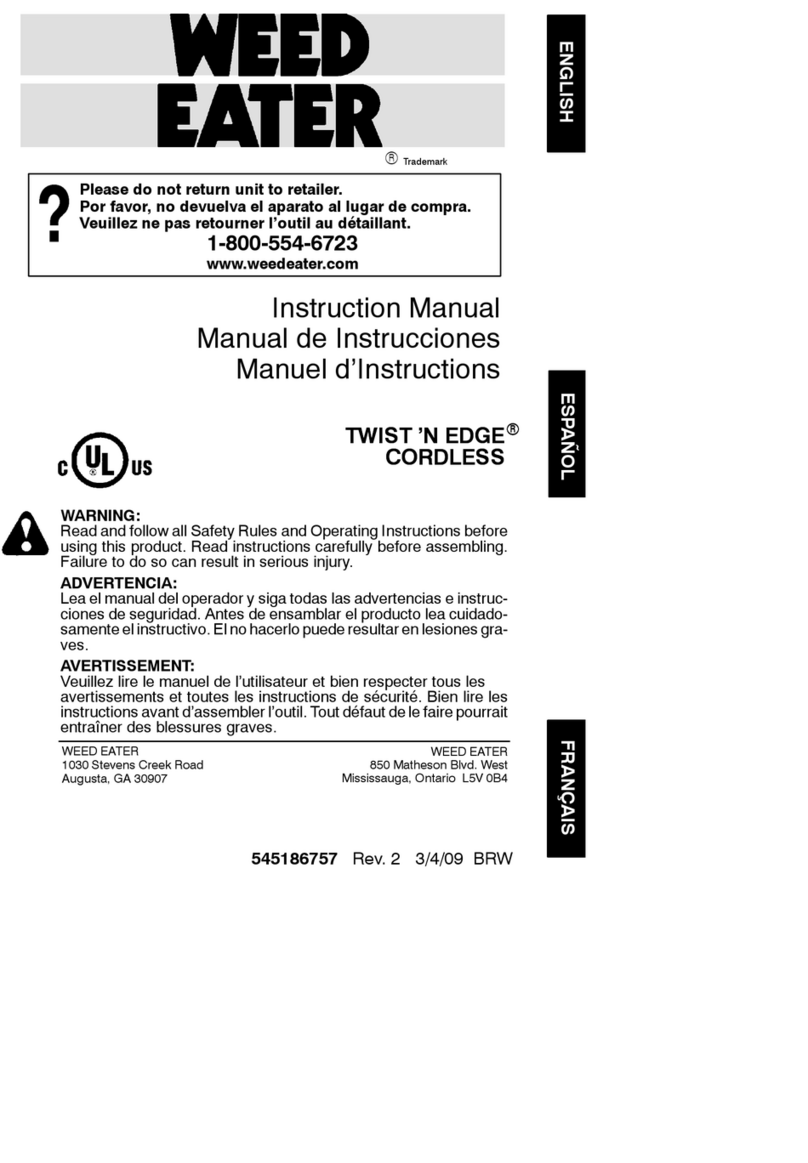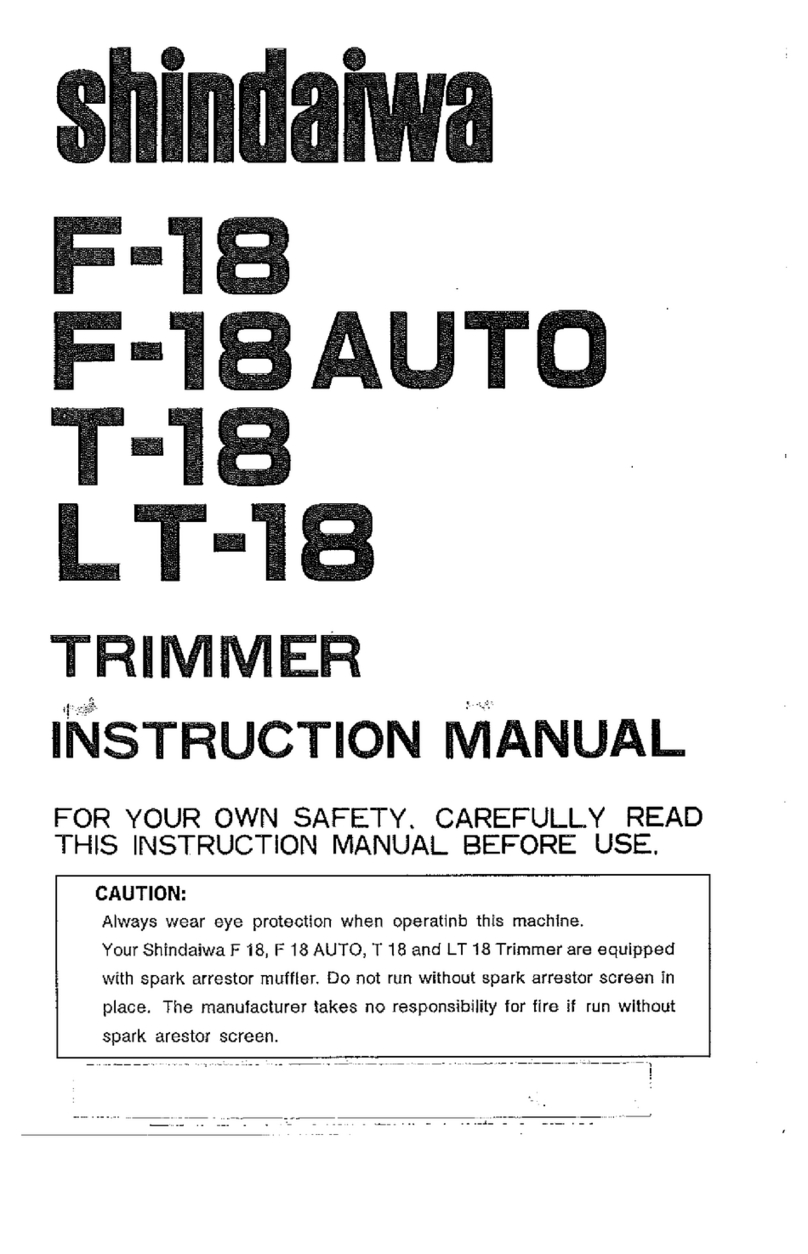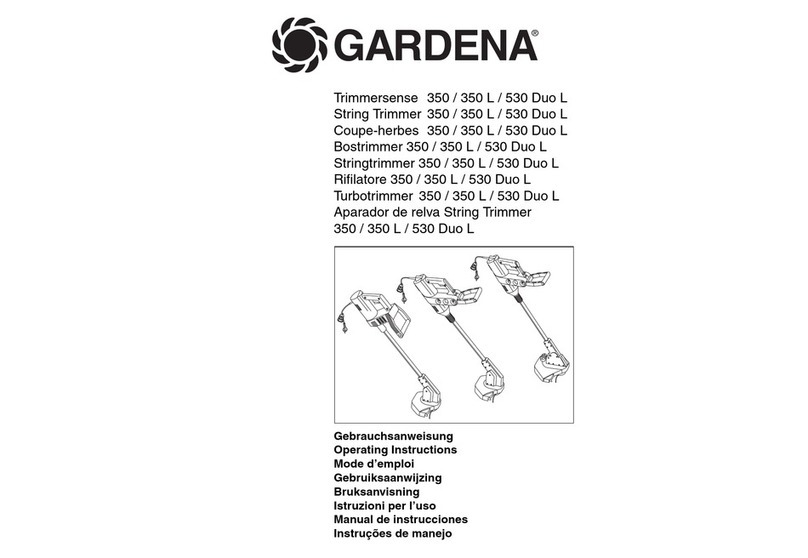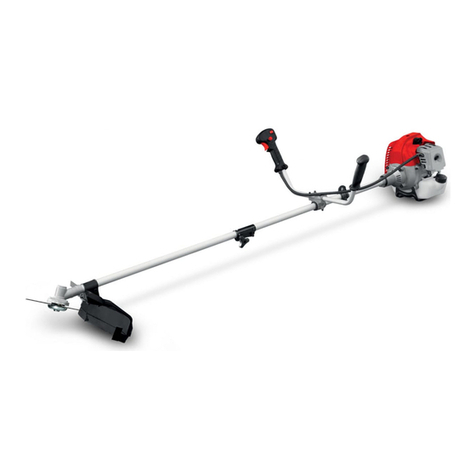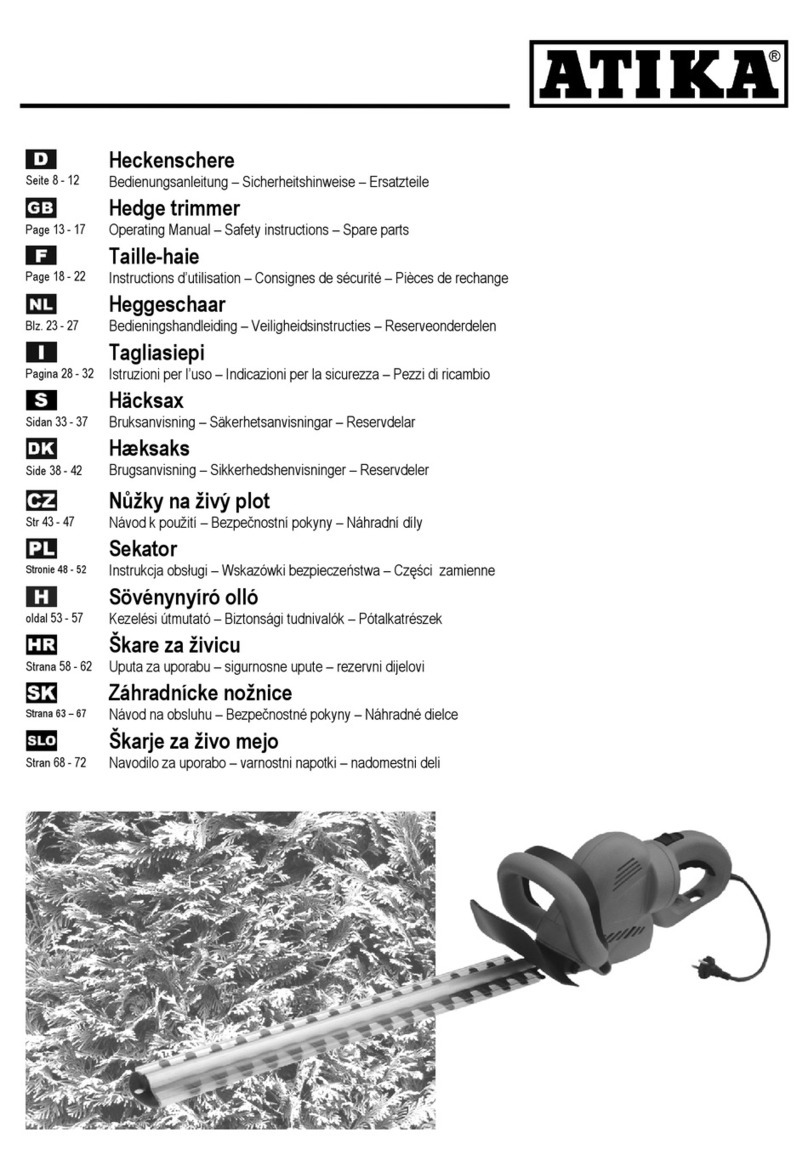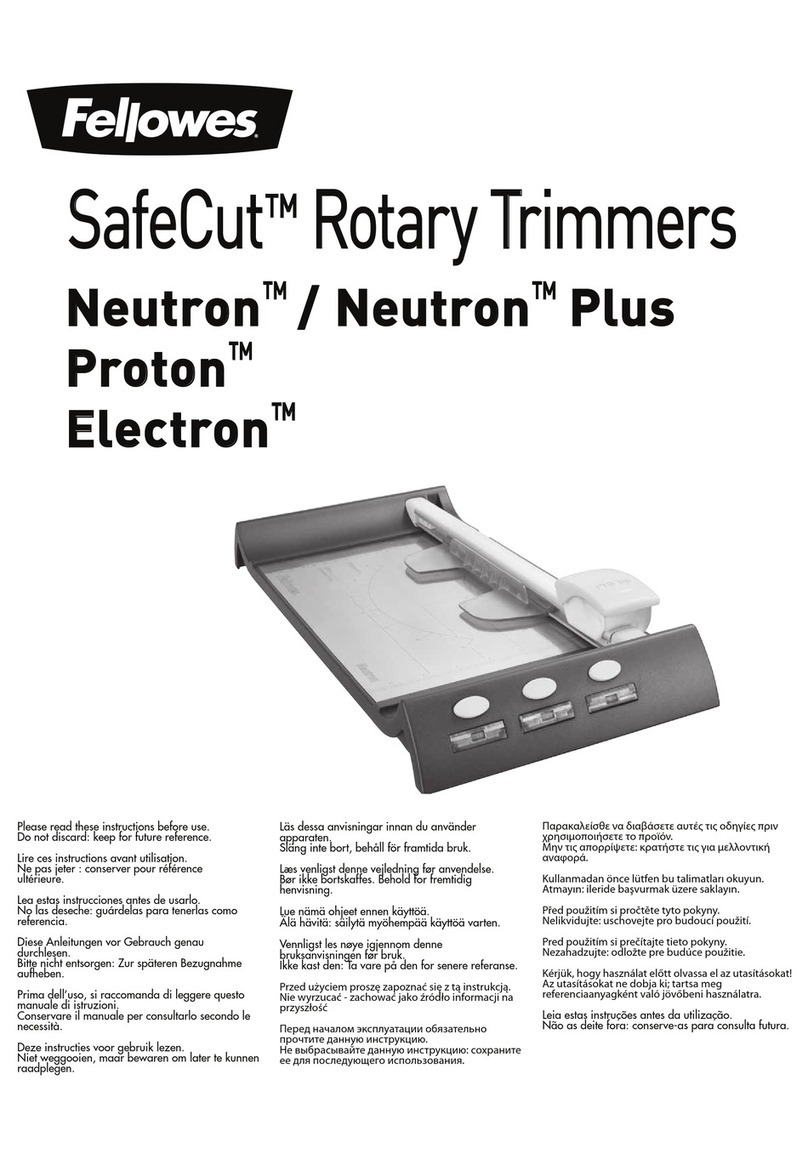Clas Ohlson DCCS301 User manual

Important!
Read the entire instruction manual carefully
and make sure that you fully understand
it before you use the equipment. Keep the
manual for future reference.
Viktig information:
Läs hela bruksanvisningen noggrant och
försäkra dig om att du har förstått den
innan du använder utrustningen. Spara
bruksanvisningen för framtida bruk.
Viktig informasjon:
Les disse anvisningene nøye og forsikre deg om
at du forstår dem, før du tar produktet ibruk.
Ta vare på anvisningene for seinere bruk.
Tärkeää tietoa:
Lue nämä ohjeet huolellisesti ja varmista
että olet ymmärtänyt ne, ennen kuin alat
käyttää laitetta. Säilytä ohjeet myöhempää
tarvetta varten.
Wichtiger Hinweis:
Vor Inbetriebnahme die komplette
Bedienungsanleitung sorgfältig
durchlesen und aufbewahren.
ENGLISHSVENSKANORSKSUOMIDEUTSCH
Art.no Model
31-8280 DCCS301
31-8281 DCCS301
31-8282 DCCS301
31-8283 DCCS301
Ver. 20141211
Original instructions
Bruksanvisning ioriginal
Original bruksanvisning
Alkuperäinen käyttöohje
Original Bedienungsanleitung
Teleskopisk häcksax/
grensåg
Teleskopisk hekksaks
Pensasleikkuri/oksasaha,
teleskooppi
Teleskop-Heckenschere/
Astsäge
HT 18
Telescopic Hedge Trimmer

2
SVERIGE
Kundtjänst tel: 0247/445 00
fax: 0247/445 09
e-post: kundservice@clasohlson.se
Internet www.clasohlson.se
Post Clas Ohlson AB, 793 85 INSJÖN
NORGE
Kundesenter tlf.: 23 21 40 00
faks: 23 21 40 80
e-post: kundesenter@clasohlson.no
Internett www.clasohlson.no
Post Clas Ohlson AS, Postboks 485 Sentrum, 0105 OSLO
SUOMI
Asiakaspalvelu puh.: 020 111 2222
sähköposti: info@clasohlson.fi
Internet www.clasohlson.fi
Osoite Clas Ohlson Oy, Maistraatinportti 4 A, 00240 HELSINKI
UNITED KINGDOM
Customer Service contact number: 020 8247 9300
Internet www.clasohlson.co.uk
Postal 10 – 13 Market Place
Kingston Upon Thames
Surrey
KT1 1JZ
DEUTSCHLAND
Kundeservice Unsere Homepage www.clasohlson.de besuchen
und auf Kundenservice klicken.

3
ENGLISH
Telescopic Hedge Trimmer
Art.no 31-8280 Model DCCS301
31-8281 DCCS301
31-8282 DCCS301
31-8283 DCCS301
Please read theentire instruction manual before using theproduct and save it for future
reference. Wereserve theright for any errors in text or images and any necessary
changes made to technicaldata. Intheevent of technical problems or other queries,
please contact our Customer Services (see address details on theinside cover).
Contents
1. Safety......................................................................................................................................... 4
1.1 General safety instructions for power tooluse................................................................................................ 4
1.2 Additional safety rules for hedge trimmers...................................................................................................... 6
1.3 Safety instructions specic to pruningsaws .................................................................................................... 7
1.4 General safety instructions for batteries and chargers .................................................................................. 7
1.5 Safety symbols........................................................................................................................................................ 8
2. Description .............................................................................................................................10
2.1 Buttons and functions.........................................................................................................................................11
3. Charging thebattery ............................................................................................................12
3.1 LED indicators.......................................................................................................................................................12
4. Assembly.................................................................................................................................13
4.1 Mounting thehandles.........................................................................................................................................13
5. Changing thecutter mechanism........................................................................................13
6. Mounting thepruning sawhead........................................................................................13
6.1 Guide bar and sawchain ....................................................................................................................................13
6.2 Chain tension........................................................................................................................................................14
7. Usingthepruningsaw .........................................................................................................15
7.1 Beforeusing ..........................................................................................................................................................15
7.2 Adjusting thetelescopicshaft...........................................................................................................................15
7.3 Workarea...............................................................................................................................................................15
7.4 Safetycheck ..........................................................................................................................................................15
7.5 Sawing technique ................................................................................................................................................16
7.6 Starting thesaw ...................................................................................................................................................17
8. Mounting thehedge trimmerhead...................................................................................17
8.1 Mounting thehandles.........................................................................................................................................17
9. Usingthehedge trimmer.....................................................................................................18
9.1 Adjusting thetelescopicshaft...........................................................................................................................18
9.2 Workarea...............................................................................................................................................................18
9.3 Safetycheck ..........................................................................................................................................................18
9.4 Starting ..................................................................................................................................................................18
9.5 Cutting/trimming.................................................................................................................................................19
10. Care and maintenance.......................................................................................................19
10.1 Hedge trimmer...................................................................................................................................................19
10.2 Pruningsaw ........................................................................................................................................................19
11. Troubleshooting..................................................................................................................20
12. Disposal ................................................................................................................................21
13. Specifications.......................................................................................................................21

4
ENGLISH
1. Safety
1.1 General safety instructions for power tooluse
Warning: Readall theinstructions. Failure to adhere to thefollowing instructions may
lead to electric shock, fires or serious injuries.
SAVE THESE INSTRUCTIONS.
Theterm “power tool” in thefollowing text refers to your handheld mains operated or
battery operatedtool.
1) Workarea
a) Keep thework area clean and well illuminated. Cluttered and poorly lit areas
invite accidents.
b) Do not use power tools in explosive environments,e.g. near to flammable
liquids, gases ordust. Powertools generate sparks that can easily ignite dust
orfumes.
c) Keep children and bystanders away from thearea where you are using
thepowertool. Distractions can cause you to lose concentration and control of
thetool.
2) Electrical safety
a) Theplug of thepower tool must fit correctly into thewall socket. Never
modify theplug in anyway. Neveruse anadaptor plug together with earthed
powertools. Unmodified plugs and suitable wall sockets minimize therisk of
electric shocks.
b) Avoid physical contact with earthed objects such as pipes, radiators, ovens
and refrigerators. Thereis anincreased risk of receiving anelectric shock if your
body is earthed.
c) Do not expose thepower tool to rain or other wet conditions. Waterentering
apower tool will increase therisk of electricshock.
d) Do not abuse themainslead. Neveruse thelead to carry/drag thetool
or to jerk theplug from awall socket. Keepthelead away from heat, oil,
sharp edges and movingparts. Damaged or tangled leads increase therisk of
electricshock.
e) When using power tools outdoors, use anextension lead that is suitable for
this purpose. Theuse of anextension lead designed for outdoor use decreases
therisk of electric shocks.
f) If using thepower tool in awet environment is unavoidable, use awall
socket equipped with aportable residual current device (RCD) for proper
safety. Useof anRCD significantly reduces therisk of electricshock.

5
ENGLISH
3) Personal safety
a) Pay attention to what you are doing and use common sense when using
powertools. Neveruse power tools if you are tired or under theinfluence of
drugs, alcohol or medication. Onemoment of inattention while using apower
tool may result in serious injury.
b) Wear protective clothing. Always wear safety glasses. Usingprotective
clothing such as dust masks, non-slip safety shoes, helmets and ear defenders
reduces therisk of injury.
c) Avoid accidental starts. Makesure that thepower switch is set to OFF before
plugging thepower tool into awall socket, fitting thebattery or picking up/
carrying thepowertool. Nevercarry apower tool with your finger on thetrigger
and never connect thepower tool to awall socket when theswitch is set to ON,
since it may result in injury.
d) Remove all service tools/keys before switching on thepowertool. Aservice
tool left on arotating part of thepower tool may result in personal injury.
e) Do not overreach. Keepproper footing and balance at alltimes. Thisenables
better control of thepower tool in unexpected situations.
f) Wear suitable clothing. Donot wear loose-fitting clothing or jewellery.
Keephair, clothes and gloves away from movingparts. Loose-fitting clothes,
jewellery or long hair could become caught in movingparts.
g) If equipment for theextraction and collection of dust is available, make sure
it is connected and properlyused. Useof dust collection equipment can reduce
dust related hazards.
4) Power tool use and maintenance
a) Do not force thepowertool. Usethecorrect power tool for your application.
Thecorrect power tool will do thejob better and safer if used at therate for which
it was designed.
b) Never use thepower tool if thepower switch does not switch thetool
on andoff. Anypower tool that cannot be controlled by thepower switch is
dangerous and must be repaired.
c) Disconnect theplug from thepower source and/or thebattery pack from
thepower tool before making any adjustments, changing accessories or
storing thepowertool. Theseprecautions reduce therisk of thepower tool
starting unexpectedly.
d) Storepower tools that are not being used out of children’sreach. Donot
allow people who are unfamiliar with thetool or its functions to operateit.
Powertools can be dangerous if they fall into thehands of inexperiencedusers.

6
ENGLISH
e) Maintain powertools. Checkfor misalignment, binding of moving
parts, broken parts or anything else which might affect theoperation of
thepowertool. Ifany damage is noticed, have thepower tool repaired
beforeusing. Manyaccidents are caused by poorly maintained powertools.
f) Keep cutting tools sharp andclean. Properly maintained cutting tools with sharp
cutting edges are less likely to bind and are easier to control.
g) Use thepower tool and any accessories in accordance with these instructions,
taking into account theworking conditions and thework to be performed.
Usingthepower tool for apurpose other than that for which it is intended could
result in adangerous situation.
5) Proper use and maintenance of cordless powertools
a) Charge thebattery using acharger recommended by themanufacturer.
b) Thetool is supplied with abattery provided by themanufacturer. Donot use
any other battery.
c) If handled incorrectly, battery fluid can leak from thebattery. If this fluid
should come into contact with skin; rinse thearea thoroughly withwater.
Always contact adoctor if battery fluid comes into contact with youreyes.
6) Service
a) Repairs and service should only be performed by qualified tradesmen, and
only with original spareparts. Thisguarantees that thesafety of thepower tool is
maintained.
1.2 Additional safety rules for hedge trimmers
• This product must not be used by anyone (including children) suffering from
physical or mental impairment. Thisproduct should not be used by anyone that
has not read theinstruction manual unless they have been instructed in its use by
someone who will take responsibility for their safety.
• Keep all bodily parts away from thecutting blades. Donot remove debris from
theblades or hold onto any material that you are cutting whilst thetrimmer blades
are in motion. Remove thebattery before dislodging any debris. Onemoment of
carelessness can result in serious personal injury.
• Never allow children to play with theproduct.
• Turn off thehedge trimmer and carry it by thehandle when moving it short
distances. Always have theblade guard in place when storing or transporting
thehedge trimmer. Correct use of thehedge trimmer will reduce thelikelihood of
personal injury caused by thecutting blades.
• Make sure that there are no foreign objects like fencing wire,etc. inthehedge/
bush that you wish totrim.
• Always hold thehedge trimmer with both hands duringuse.
• Theblades will continue in motion for afew seconds after thepower has been
turnedoff. Note: Donot touch theblades while they are in motion.

7
ENGLISH
• Keep all bodily parts away from thecutting blades. Donot remove debris from
theblades or hold onto any material that you are cutting whilst thetrimmer blades
are in motion. Remove thebattery before dislodging any debris.
• Always switch off thehedge trimmer and have theblade guard mounted in place
whenever moving or transportingit.
• Always inspect thehedge before cutting it to make sure that it does not contain
any foreign objects.
• Always hold thehedge trimmer with both hands duringuse.
1.3 Safety instructions specic to pruningsaws
• Bear in mind that theproduct’s use might be restricted by national or local
regulations. Findout if any restrictions apply to yourarea.
• Asafe working distance of at least 10 m must always be maintained between
theproduct and any high-voltage power cables.
• Read and make sure you understand theinstruction manual before using
theproduct.
• Always make sure that you are well-balanced when using thesaw. Takeregular
breaks when working for long periods.
• Maintain afirm stance and posture and always use thesupplied carrying harness.
• Keep bystanders at asafe distance from theworkarea.
• Always saw branches into smaller pieces, starting at thetip and working in
towards thetrunk. Beaware of your position to avoid being struck by falling
branches.
• Never operate theproduct if any of its safety devices is missing or damaged.
• Use protective eyewear and hearing protection. Further protective equipment
for head, hands, legs and feet is recommended. Wearing thecorrect protective
equipment reduces therisk of personal injury from flying debris or accidental
contact with thesawchain.
1.4 General safety instructions for batteries and chargers
a) Always be careful of inadvertent starts while attaching thebattery. Makesure that
both thesafety catch and start trigger are not engaged.
b) Only use theincluded battery charger or acharger recommended by
themanufacturer. Thebattery charger is only designed to charge certain types of
batteries. Ifacharger designed for another type of battery is used therisk for fire or
explosion is significantly increased.
c) Only use batteries designed for theelectric power tool it was specifically
designedfor. Useof any other types of batteries can lead to fire and/or bodily injury.
d) Keep unused batteries asafe distance away from paper clips, screws, nails
and other metal objects that could potentially short-circuit thebattery terminals.
Short-circuiting thebattery terminals can lead to fire or explosion.

8
ENGLISH
e) Battery fluid can leak from thebattery if it is damaged. Avoidphysical contact with
thisfluid. Ifthis fluid comes into contact with skin; rinse thearea thoroughly withwater.
Ifthefluid comes into contact with theeyes, seek medical attention immediately.
Fluidwhich has leaked from abattery pack can cause skin irritation orburns.
• Thebattery can become hot after alonger period ofuse. Letit cool before
attempting to rechargeit.
• Never attempt to open thebattery casing.
• Never store abattery in direct sunlight or at temperatures above 40°C.
• Only charge thebattery when theambient temperature is between 10°C and 40°C.
• Never expose thebattery or charger towater.
• Keep thecharger and batteries out of thereach of children.
• Never use thebattery charger or batteries in environments where flammable liquids
or gases are stored.
• Always transport batteries in asafe manner ensuring that they do not come into
contact with each other and never in ametal container.
• Check that thebattery charger and mains lead are whole and undamaged
beforeuse.
• Charge thebattery completely if it is not to be used for anextended period.
• Thebattery must only be charged with acharger that conforms to EN60335-2-29
standards.
1.5 Safety symbols
Read theentire instruction manual.
Safety helmet, eye protection and ear protection must beworn.
Safety gloves must beworn.
Safety shoes must beworn.
Asafe distance of 10 m from thehigh-voltage cable must always be
maintained.

9
ENGLISH
Do not expose theelectric power tool torain.
Keep all bodily parts away from thecutting mechanism (saw chain,
hedge trimmer blades) during start and while using theelectric
powertool.
Keep all bystanders at asafe distance from theworksite.
Foreignobjects can be propelled from theelectric power tool duringuse.
Warning: Bystanders and pets should be kept at asafe distance while
theelectric power tool is inuse.
Note: Remove thebattery from theelectric power tool before any care
or maintenance is performed.

10
ENGLISH
1 2 3 4 5 6 7 8 9 10
11 12 13 14 15 16 17
18 19 20 21
22 23 24 25
26
2. Description
• 31-8280 Telescopic hedge trimmer, thefollowing parts come unmounted:
Rearhandle, cutting mechanism (hedge trimmer head), front handle,
telescopic shaft and shoulderstrap.
• 31-8281 Telescopic pruning saw, thefollowing parts come unmounted:
Rearhandle, cutting mechanism (pruning saw head), front handle,
telescopic shaft, shoulder strap, bar andchain.
• 31-8282 Hedge trimmer head (complete, ready-to-use cutting mechanism)
• 31-8283 Pruning saw head (complete, partially unassembled cutting mechanism)

11
ENGLISH
27 28
2.1 Buttons and functions
1. Front handle lock-lever clamp and angle adjustment lockknob
2. Shoulder strap anchorpoint
3. Shoulderstrap
4. Telescopicshaft
5. Rear handle lock collar
6. Adjustable rear handlepivot
7. Safetycatch
8. Power trigger
9. Rear handle
10. Battery mount (battery sold separately)
Pruningsaw
11. Guidebar
12. Sawchain
13. Spiked bumper
14. Oil reservoir with filler cap and min and max graduations
15. Cutter head release button
16. Adjustable drive motorpivot
17. Telescopic shaft lockknob
18. Rotation directionmark
19. Drivecover
20. Guide barbolt
21. Spring washer
22. Drive sprocket
23. Guide bar tensioningpin
24. Saw chain tensioning hexscrew
25. Saw chainguard
26. Combination spanner
Hedge trimmer
27. Saw chainguard
28. Cutting bar with blades

12
ENGLISH
3. Charging thebattery
(Note: Battery and charger sold separately.)
Temperature range for charging and storing thebattery: 0–40ºC.
1. Depress thebattery release catch on top of thebattery and slide it out from
thebatterymount.
2. Putthebattery into its charger cradle and make sure that it clicks securely intoplace.
3. Connect themains lead of thecharger to a230 V, 50Hz electrical socket.
4. Crossreference thebattery charger LEDs on top of thecharger to ensure proper
charging is in progress.
5. Oncecharging is complete, press thebattery release catch and remove it from
thecharger.
3.1 LED indicators
1/sec
3/sec
Steady green light and red lightoff:
Charger connected but no current charge is in progress.
(Nothing will happen if afully-charged battery is connected to thecharger.)
Red light flashing once per second and steady greenlight:
Charging is in progress.
Steady green and redlight:
Fully-charged battery.
Red light flashing three times per second and steady greenlight:
Faulty battery.
Note:
• Thelithium-ion battery has abuilt-in electronic deep discharge protection preventing
it from working at reducedpower. Fullpower is provided until theelectronic
protection circuit switches off thecurrent, indicating that thebattery needs to be
recharged. Thetool will be switched off automatically. Donot attempt to continue
work after this point, as doing so may damage thebattery.
• Thebattery also has abuilt-in electronic overload protection. Ifthetool is put under
too much stress, theelectronics automatically cut thepower and thetoolstops.
Release thetrigger and wait afew seconds before switching thetrimmer onagain.
• Thelithium-ion battery has no memory which means that it can be charged at any
time regardless of batterylevel.
• Charge thebattery for at least 6 hours thefirst and second time it is charged.
• For long-term storage, thebattery should be fully charged at least every 6 months.

13
ENGLISH
19 20 21
4. Assembly
4.1 Mounting thehandles
Back handle
Slide theback handle (9) securely onto the telescopic shaft (it only fits one way) and
screw on thelock collar (5) tightly to secure thehandle.
Front handle
Thefront handle mount is pre-mounted.
Attach thefront handle to themount, set thedesired angle and tighten thelockknob.
5. Changing thecutter mechanism
Removing thecutter mechanism: Pressand hold thecutter head release button (15),
rotate thecutter head so that its [▼] arrow is aligned with the [▲] arrow on thedrive
motor and remove thecutter head from thedrivemotor.
Mounting thecutter mechanism: Pressand hold thecutter head release button and
align the [▼] arrow on thecutter head with the [▲] arrow on thedrive motor and
attach thecutterhead. Thenrotate thecutter head so that thearrow now aligns with
thelock symbol. Twistthecutter head to click-lock thecutter head securely in place
and making sure its arrow is directly aligned with thelock symbol. Adistinct click will
be heard when thespring-loaded bayonet lock (15) catches into place indicating that
thelock is securely engaged.
6. Mounting thepruning sawhead
6.1 Guide bar and sawchain
Note: Always check that thebattery is removed before starting.
Note: Thesaw chain teeth are verysharp. Always wear protective gloves.
1. Unscrew theguide bar bolt (20),
remove thespring washer (21) and
drive cover (19).

14
ENGLISH
23
24
2. Place thesaw chain onto theguidebar.
3. Position theguide bar so that thechain
tensioning pin (23) engages into thehole on
theguide bar and thesaw chain is around
thechain sprocket. Note: Makesure thesaw
chain is theright wayround. Referto
theguide bar and saw chain illustration.
4. Refit thedrive cover, spring washer and
finger-tighten theguide barbolt. Donot
tighten thebolt completely until thesaw
chain has been satisfactorily tensioned.
6.2 Chain tension
Note: Anew saw chain stretches during use and should be checked and readjusted
after just afew minutesuse. Thechain tension should be checked regularly.
Thechain should not be so slack that it is hanging down away from thechainbar.
Youshould only be able to lift thechain about 2 mm up from thechainbar.
1. Turnthesaw chain by hand to make
sure that it is running correctly around
theguidebar. Wearprotective gloves as
thechain issharp!
2. Adjust thechain tension by turning
thetensioning screw (24) clockwise
until thechain is tensioned correctly as
describedabove. Usethesuppliedtool.
3. Tighten theguide bar bolt securely.
2 mm

15
ENGLISH
7. Usingthepruningsaw
Note: Always make sure that thebattery is removed before carrying out any type of
maintenance, longer transport or cleaning.
Note: Thesaw chain must always be sharp and correctly tensioned for ensuring
proper and safe tree pruning. Haveaprofessional sharpen thechain for you if you are
not sure how to doit.
7.1 Beforeusing
Top up with saw chainoil. Note: Onlyuse agood quality saw chainoil.
1. Setthesaw down securely onto theground.
2. Opentheoil reservoircap.
3. Carefully fill theoil reservoir.
4. Checkthefiller cap gasket and change replace if damaged. Keepthearea around
thefiller cap free of dirt so that none gets into thereservoir.
5. Screwtheoil filler cap backon.
6. Wipeup any spilledoil.
7. Checkfor proper saw chain lubrication. Referto theStarting thesaw sectionbelow.
7.2 Adjusting thetelescopicshaft
Thetelescopic shaft has two lock-collars for length adjustment.
1. Loosen both lock-collars (17).
2. Setthetelescopic shaft (4) to thedesired length.
3. Tighten thelock-collars.
4. Secure theshoulder strap to its anchor point (2).
7.3 Workarea
• Always keep thework area tidy so you can move freely without therisk of tripping
over obstacles.
• Make sure that there are no loose branches which could become caught in thesaw.
7.4 Safetycheck
1. Makesure that you are wearing all required safety gear before starting.
2. Makesure that all parts of thesaw are whole, accounted for and undamaged.
3. Makesure that thesaw chain is correctly tensioned.

16
ENGLISH
1
3
42
7.5 Sawing technique
It is advisable to practice your sawing technique on easily accessible branchesfirst.
Thiswill allow you to comfortably practice your sawing technique in various situations.
Itwill then be easier and safer for you to progress onto using more advanced sawing
techniques.
Note: Neversaw into bushes or thin branches. Thesecan get caught in thesaw chain
and cause thesaw to be thrown out of control.
Pull sawing (recommended)
Always use thebottom side of theblade for cutting
branches. This technique involves sawing branches
from thetop to thebottom. Thesaw chain pulls
thesaw forwards, away from theuser. Whenpull
sawing, theuser has much more control over thesaw
and can better avoid kickbacks.
Push sawing
This technique involves sawing thebranch from
thebottom to thetop. Thesaw chain thus pulls
thesaw back towards theuser. This means that
theuser has to equalise therearward force of thesaw
chain to compensate. If theforce is not equalised,
there is adanger of theguide bar being pulled too
far backwards so that just thetip of thebar is in
contact with thebranch. Thiscan cause kickbacks or
unexpected bar movement.
Lopping o branches
When sawing thinner branches, it is usually sufficient
to employ thepull sawing technique. When sawing
thicker branches, use thefollowing technique:
1. Makethefirst cut from below, about 15–20 cm
from thetreetrunk. Cutabout 1/3 of theway
through thebranch.
2. Makethesecond cut about 5–10 cm outside
thefirstcut. Cutfrom above and cut all theway
through thebranch.
3. Placethethird cut as close to thetree trunk
as possible. Cutabout 1/3 of theway through
thebranch. Sawfrom thebottom.
4. Makethefourth cut as close thetree trunk as
possible and cut all theway through thebranch.
Sawfrom thetop.

17
ENGLISH
Note:
• Always begin with thebranches lowest down on thetrunk.
• Always stand in awell-balanced stable stance.
• Never work whilst standing on aladder.
• Never saw off abranch which is directly above yourhead.
• Never overreach, lean too far forward or too far backward.
• Never work in poor light or weather conditions.
• Always use thecarrying harness.
• Tidy thework area before beginning work and check thesurroundings for foreign
objects that may interfere with proper work safety.
• Always hold thesaw with bothhands.
7.6 Starting thesaw
1. Mountthebattery.
2. Holdin thesafety catch (4) and pull and hold thepower trigger (6) tostart.
Release thesafety catch but continue to grip power trigger pulled in for
continuous operation.
3. Checkfor proper saw chain lubrication. Pointthetip of thechain bar about
10–15 cm away from asolid light-coloured object and start thesaw. Afterabout
30 seconds of running, aline of oil should be visible on theobject.
4. Allowthesaw chain to reach full speed before beginning tosaw.
5. Thesaw will stop automatically if thepower trigger is released.
8. Mounting thehedge trimmerhead
Thehedge trimmer head is fully assembled and ready to use and only needs to be
mounted onto thedrivemotor.
8.1 Mounting thehandles
Back handle
Slide theback handle (9) securely onto the telescopic shaft (it only fits one way) and
screw on thelock collar (5) tightly to secure thehandle.
Front handle
Thefront handle mount is pre-mounted.
Attach thefront handle to themount, set thedesired angle and tighten thelockknob.

18
ENGLISH
9. Usingthehedge trimmer
9.1 Adjusting thetelescopicshaft
Thetelescopic shaft has two lock-collars for length adjustment.
1. Loosen both lock-collars (17).
2. Setthetelescopic shaft (4) to thedesired length.
3. Tighten thelock-collars.
4. Secure theshoulder strap to its anchor point (2).
9.2 Workarea
• Always keep thework area tidy so you can move freely without therisk of tripping
over obstacles.
• Make sure that there are no loose branches which could become caught in
thecutting mechanism.
9.3 Safetycheck
1. Makesure that you are wearing all required safety gear before starting.
2. Makesure that all parts of thehedge trimmer head are whole, accounted for and
undamaged.
3. Makesure that theblades are sharp and lubricated.
9.4 Starting
Pre-start inspection routine:
• Check that theventilation ports of themotor are free andclear.
• Check that thecutting mechanism and battery are whole and undamaged.
• Check that both thesafety catch (7) and power trigger (8) are easily depressed and
release easily, and that they do not catch or function abnormally in any otherway.
• Check that both handles are clean and easily gripped.
1. Remove theguard from thecutting mechanism.
2. Attach thebattery making sure that it clicks securely intoplace.
3. Pressand hold thesafety catch (4) and then pull thepower trigger (3). Thetrimmer
should nowstart. Note: Release thesafety catch but continue to grip power
trigger pulled in for continuous operation.
4. Thehedge trimmer will stop automatically if thepower trigger is released.
Note: Sparks may sometimes be noticed inside themotor housing when themotor is
turnedoff. Thisis completely normal.

19
ENGLISH
9.5 Cutting/trimming
• Make sure that there are no hidden obstacles (metal poles/wire fences) in thearea
to be trimmed.
• Max branchdiam: 15mm.
• Hold thetrimmer firmly; maintain asteady stance and do not lean out toofar.
Beextra careful when using aladder.
• Move thetrimmer along in aslow and steady motion following theline ofcut.
• Thedouble-sided cutter bar enables trimming in both directions or in asweeping
motion from side toside.
• For even trimming on thesides of hedges, it is better to cut in thedirection of
growth, from thebottomup.
• If you trim from thetop down, thethinner twigs will bend out and there is arisk of
holes or thin patches appearing in yourhedge.
• In order to ensure astraight top edge, you can stretch alength of string over
thehedge as aguide.
10. Care and maintenance
10.1 Hedge trimmer
Note: Remove thebattery before cleaning or adjusting thetrimmer.
• Do not expose thehedge trimmer torain.
• Wear protective gloves when handling or cleaning theblades.
• Regularly check that thestart switch and safety lock are undamaged and
workcorrectly.
• Regularly check thecondition of theblades and make sure that all screws in
thecutter bar are tight and secure.
• Lubricate thecutter bar with anappropriate lubricant if thetrimmer is not to be
used for alongtime.
• Clean theexterior of thetool with asoft brush andcloth.
• Do not use any water, solvents or polish for cleaning or other maintenance.
• Remove all dirt, especially from around themotor ventilationports.
• Store thetrimmer in adry, dust-free environment out of thereach of children.
• Do not store thebattery in temperatures belowzero.
• Always keep theblade guard on when thehedge trimmer is not inuse.
10.2 Pruningsaw
Note: Always make sure that thebattery is removed before conducting any type of
maintenance, longer transport or cleaning.
• For proper safe and satisfactory operation, always keep thesaw chain sharp and
correctly tensioned. Haveaprofessional sharpen thechain for you if you are not
sure how to doit.
• Make sure that theventilation openings of themotor are keptclear.

20
ENGLISH
29
• Regularly remove thechain and bar and
clean theoil guide groove (29) and thearea
around thechain drive sprocket.
• Clean theexterior of theproduct using
alightly moistenedcloth. Useonly mild
cleaning agents, never solvents or corrosive
chemicals.
• Always put thechain guard over thebar
and carry thesaw with thebar pointing
backwards when moving location.
• If thesaw is not to be used for along time,
always drain thechain oil and store thesaw
horizontally in adry, well-ventilatedplace.
11. Troubleshooting
Themotor will notstart.
• Is thebattery charged?
• Have both thesafety catch and power trigger been depressed and held down at
thesame time duringstart?
Poor cutting performance.
• Check thesharpness of thechain.
• Check thetension of thechain, see theChain tension sectionabove.
• Incorrectly fitted chain, check direction of rotation.
Thehedge trimmer bar and blades become overheated.
• Lubricate theblades and sharpen them if necessary.
Poor battery operatingtime.
• Thecutter mechanism runs sluggishly. Cleanand lubricate thecutter bar and blades.
• Thebattery is not fully charged.
• Thebattery needs replacing.
Thebattery does not charge.
• Thebattery is not correctly mounted onto thecharger.
• Thebattery or charger contacts aredirty.
• Themains lead is not properly plugged into thewall socket.
• Check to see if there is power at thewall socket.
• Thecharger or its cable is damaged.
• Thebattery is defective and must be replaced.
Table of contents
Languages:
Other Clas Ohlson Trimmer manuals
